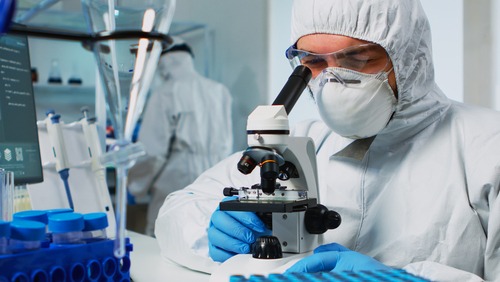
Federal agencies, Congress and the White House must jointly foster improved research and development for pandemic preparedness and response, experts said during a recent webinar hosted by the Capitol Hill Steering Committee on Pandemic Preparedness & Health Security.
“Over the last two years, the United States and the rest of the world have really seen the immense value of research and development in terms of new tools technologies, drugs and vaccines to combat infectious disease threats,” said panel moderator Anita Cicero, deputy director at the Johns Hopkins Center for Health Security, which manages the steering committee.
“It’s vital to examine how federal agencies, Congress and the White House can reimagine how they work with each other and the private sector to foster greater agility, speed, innovation and coordination in research and development for pandemic readiness,” Cicero said during the Nov. 17 webinar, “Modernizing Research & Development for Pandemic Readiness.”
Former U.S. Rep. Susan Brooks (R-IN), an honorary founding member of the steering committee, pointed out that the United States is “completely and rightly” considered a global leader in R&D and in technological innovation.
“Yet, during my tenure in Congress, it was clear that the federal bureaucracy was often not known for being nimble or for its transparency or its ability to work outside the rigid guidelines and meet funding mechanisms with non-federal partners,” said Brooks. “However, what the COVID-19 pandemic did show us is that the federal government is quite capable of harnessing biomedical innovation with the private sector to deliver effective vaccines and therapeutics faster than we ever thought possible.”
In fact, during the ongoing COVID-19 pandemic, the U.S. government has robustly funded public-private partnerships, which Brooks said have the potential to improve the nation’s ability to detect and contain deadly pathogens.
“So, in order to be better prepared for future threats and potentially prevent future pandemics, we have to modernize our research and development, we have to leverage new technologies and incentivize collaboration,” she said. “And we must incorporate this reality across the many federal agencies that are involved.”
Toward that goal, said Brooks, the questions now are: What structural changes are needed; what funding is required; what strategies must be institutionalized; and how can the government efficiently lead and coordinate these efforts?
One answer, according to Dr. Eric Lander, director of the White House Office of Science and Technology Policy, is the American Pandemic Preparedness Plan, which the Biden administration released in September for transforming U.S. capabilities to prepare for and respond rapidly and effectively to future pandemics and other high-consequence biological threats.
Lander said the whole-of-government plan, which among numerous goals authorizes $65 billion over a decade, aims to achieve these capabilities by a systematic effort and shared vision for biological preparedness across the federal government.
For instance, many agencies must be involved along with Congress, which provides the legislative authority, and the White House, including the Department of Defense, the Food and Drug Administration (FDA), and the Department of Health and Human Services (HHS), Lander said. Together, they must coordinate on getting out vaccines and therapeutics quicker; providing early warning systems to identify earlier the appearances of viruses with pandemic potential; providing real-time monitoring on where such viruses are headed; and innovating on personal protective equipment (PPE), for example.
Specifically, several of the five key areas necessary to protect the United States against biological threats, according to the plan, include dramatically improving and expanding the U.S. arsenal of vaccines, therapeutics and diagnostics; ensuring situational awareness about infectious-disease threats, for both early warning and real-time monitoring; and building core capabilities, including PPE, stockpiles and supply chains, biosafety and biosecurity, and regulatory improvement.
“Everything has to come together seamlessly,” he said, “it must be driven by transparency, and there needs to be funding on a continual basis.”
Dawn O’Connell, Assistant Secretary for Preparedness and Response (ASPR) in HHS, explained how her office is already on board with the president’s plan.
ASPR’s “fundamental mission is to help strengthen the health security of the nation and we’ve learned a lot in this pandemic that we want to be sure to apply moving forward as we look at modernizing research and development,” O’Connell said during the webinar.
In fact, the Biomedical Advanced Research and Development Authority (BARDA), which is a sub-agency within ASPR, is the only federal entity dedicated to the advanced stages of development to get emergency medical countermeasures over the regulatory finish line and make them available under a full FDA approval, she said.
“Some of our terrific partners cover the early stages of R&D; BARDA picks up for phase two and phase three clinical trials, manufacturing process work, and regulatory support needed to do this work,” O’Connell said. “BARDA works closely with private industry partners to support and guide our development efforts and during COVID [has] worked with over 100 private companies on diagnostics, treatments, vaccines, and other technologies.”
This approach is one that she thinks the nation needs to help it maintain an ongoing faster paced and engaging relationship with the private industry. “Moving forward, as we look at what worked and what didn’t, we want to capture and retain those places where BARDA innovated along the way,” O’Connell said.
For example, BARDA learned that it’s not enough to focus just on innovation and rapid development practices. “We also have to be sure we have the components necessary to manufacture and administer medical countermeasures [while also] securing the public health supply chain,” said O’Connell.
The supply chain is complex, comprises different private-sector players and market dynamics across multiple domains of medical equipment and supplies, O’Connell explained, noting that she’s working to integrate and organize supply chain situational awareness, industrial analysis, domestic industrial base expansion, and supply chain logistics all into a new office within ASPR slated to be operational in the beginning of 2022.
“We are all working together on novel countermeasure portfolios to prepare for whatever comes next,” O’Connell said, “and unfortunately we know something will come next.”




